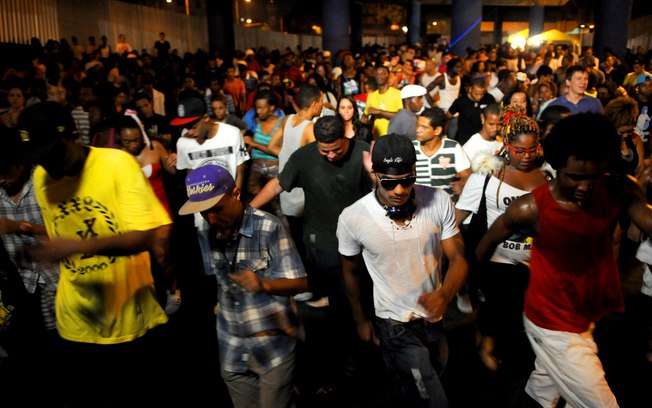Dance is an often overlooked, central part of many of the music scenes we are interested in at Dutty Artz. It has been important for us since the early days — when Matt Shadetek’s Brooklyn Anthem became dubbed Craziest Riddim and spread like fire amongst the Brooklyn-teen Dancehall scene. Today so many local dances and DJ scenes have such an intimate symbiotic relationship, so I’m gonna start a new column here to put some of the developments in musically-informed body movement back at the center of our attention:
Since the world is currently focused on Brazil, and I’m based in Rio, I wanted to start by highlighting a local dance phenomenon in my own backyard:
[youtube]http://www.youtube.com/watch?v=YKE-oSQvQUs&list=FLKpsIaut0D0rW_Swm1oWhWA&feature=share[/youtube]
This scene, that looks like it could take place in any U.S. city, is Baile Charme. The above video takes place in Madureira, a neighborhood with an historical Afro-Brazilian community in Rio’s North Zone, and the epicenter of the Baile Charme movement. The coordinated dances to smooth American R&B tunes seemed out of place when I first saw them in Rio. But after understanding that this North American expression of blackness was one of the few places for black-identifying people in the city to congregate, I realized that such a movement was actually somewhat of a political statement. The mission statement of the Baile Black Bom party at Pedra do Sal explicitly states that they, “are a Baile Black who’s purpose is to valorize black culture through music, literature, and afro-entrepreneurship.”
Granted, Samba is ostensibly Afro-Brazilian, and many of its stars are black Brazilians. However, with the help of the Estado Novo, it was fully appropriated by white Brazilians and became a symbol of a multi-racial Brazilian-ness. Funk music came out of a very similar Baile Black scene in Rio, but after co-option by drug dealers, and the focus on lyrics that depict sex and violence, an explicit blackness has been weened out of a genre that now represents the (multi-racial) favelas. So, what results across Brazil is that expressions of blackness are often done through the appropriation of foreign cultures, which can’t be appropriated as Brazilian by the greater population. Jamaican and the U.S. cultures, with strong histories of black empowerment movements become a convenient way to channel this identity.
To see the roots of the scene, check out my favorite scene from the movie Cidade de Deus, which takes place during a Baile Black/Old School Funk Party in that neighborhood:
[youtube]http://youtu.be/BnrKndkqLaY[/youtube]
In the states, the coordinated line dance style, isn’t as has hip as twerking today. But it, does still have its space in U.S. culture. Two of the biggest line dances of the last decade, and staples of the black Midwestern and Southern family reunion/wedding scene were the Cupid Shuffle, and the Cha Cha Slide. Of course the black fraternities on U.S. College campuses are the most fervent defenders (and innovators) of the tradition:
[youtube]http://youtu.be/WjC2AHdu4F4[/youtube]
And in Oakland, the spiritual home of the hyphy movement (if Vallejo was its creative epicenter), a new hybrid twerk-step dance called Yiken has emerged (apparently merging with moves from the Gas Pedal.) Many of the moves are R-rated, what I initially called hyphy daggering, but this group of ladies really shows the creative side of the dance, and the energy of a place like the Town:
[youtube]http://youtu.be/D9mkZNYTcf0[/youtube]
Funnily enough, I just saw this post shared on Twitter by Wayne. Proof that black dance just keeps recycling itself for different contexts – even internationally!
